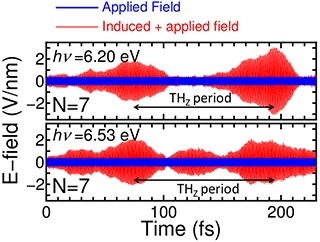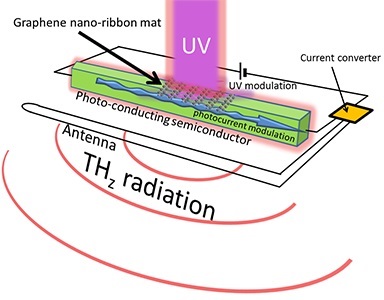02/12/2016
Yoshiyuki Miyamoto of Materials Interface Simulation Group, the Nanomaterials Research Institute, the National Institute of Advanced Industrial Science and Technology, in collaboration with Hong Zhang and Xinlu Cheng of Sichuan University and Angel Rubio, Max Planck Institute for Structure and Dynamics of Matters, theoretically presented terahertz (THz) modulation of UV light by a graphene nano-ribbon from computational simulation and proposed the application to a terahertz radiation device.
This simulation shows that the intensity of UV light passing through a graphene nano-ribbon is modulated with the frequency of terahertz. When such modulated UV light shines on a semiconductor which has a photo-conducting property, the semiconductor generates a photo-current whose intensity is modulated with a terahertz frequency. Therefore, such a photo-conducting semiconductor connected to an antenna is expected to be a source of terahertz radiation. This idea might lead to the production of compact terahertz-radiation devices which are useful for identification of organic compounds as well as observation of living matter.
The details of the current simulation have been published in Nanoscale, a journal published by the Royal Society of Chemistry (England).
Applications of graphene attract a lot of attention and graphene devices having highly conductive electron- and hole-carriers are being studied (AIST press release on December 11, 2012). However, for optical-devices, the highly conductive properties are not always beneficial. On the other hand, graphene nano-ribbons, which are obtained by cutting a graphene sheet into ribbons, have a band-gap and a semiconducting property, and light absorption/transmission properties of the graphene nano-ribbons have been studied.
Terahertz waves are known to be useful for identification of harmful substances and inspecting degradation of buildings. However, it is difficult to fabricate strong terahertz radiation devices with compact sizes and low cost.

Simulated total field (red) and optical field (blue) near the surface of the graphene nano-ribbon with photon energies of 6.20 eV and 6.53 eV, respectively
AIST is aiming at the acceleration of research and development of nano-scale materials by designing using computational simulations. By simulating dynamics of electrons and atoms in materials with first-principles calculations, electron dynamics of irradiated materials and optical responses of nano-scaled materials such as graphene were studied (AIST press release on March 18, 2015).
In this work, the application of graphene nano-ribbons was discussed by AIST and Sichuan University, and the usage of first-principles methods and data analysis were considered by the Max Planck Institute for Structure and Dynamics of Matters. Then AIST performed numerical calculations. This work was done with financial support by MEXT Grant-in-Aid for Scientific Research on Innovative Area, “Science of Atomic Layers (SATL),” (FY2013 - FY2017) and all computations were performed by using the Large-Scale Computer System in the Cybermedia Center of Osaka University.
In the present work, the researchers found terahertz modulation of the intensity of UV light passing through a graphene nano-ribbon by a simulation and proposed a terahertz radiation device using the discovered phenomenon. The graphene nano-ribbon, which is a one-dimensional material having a band-gap like semiconductors, is the current object. The edge of the graphene nano-ribbon was assumed to have an armchair structure with carbon atoms at the edge terminated by hydrogen atoms (Fig. 1). By performing a first-principles calculation based on the time-dependent density functional theory to simulate the irradiation of UV light with polarization vector shown in Fig. 1, oscillation of electrons running from one edge of the grapheme nano-ribbon to the other edge alternatively was computed. This suggests, that the oscillation of the electron cloud in the graphene nano-ribbon is following the oscillation of optical field of the UV light. If the eigen frequency of the electronic oscillation is close to that of the optical frequency, resonance is expected to occur. The first-principles simulation showed resonance of the optical field and the electron cloud with UV light irradiation (photon energy is around 6 eV), and periodic enhancement and decay in amplitude of the electron-cloud oscillation was computed.
Frequencies from 0.5 THz to 5 THz are practically useful region of terahertz radiation. Besides graphene nano-ribbons, further exploration will be made for new materials that can be used for radiation with frequencies from 0.5 THz to 5 THz. In the exploration, the wavelength of the incident light spanning UV, visible, and infrared regions will be the target.













